|
Kyabpa Jigten Sumgon belonged to one of the highest Tibetan clans, the Kyura family, known as the Miu Dhondruk clan. He crowned Khenchen Gura-wa Tsultrim Dorjee (1246-1220) as the first throne-holder of the Drikung Kagyu Order. Beginning with Tsultrim Dorjee, the Drikung Kagyu Order had up to 23 throne-holders, who were descendants of the Kyura clan and served as the head of the Order. The 24th throne-holder was Drikung Kyabgon Chetsang Konchok Khriley who was recognized as the second reincarnation of Konchok Rana (1590-1654). Konchok Rana was the 22nd throne-holder. The 23rd throne-holder was Kunkyen Rigzin Chokyi Drakpa (1595-1654) who was recognized as the first Drikung Kyabgon Chungtsang Rinpoche. Konchok Rana was the elder brother of Kunkyen Rigzin Chokyi Drakpa. This is the reason why the reincarnations of Konchok Rana are referred to as Chetsang (the elder) and the reincarnations of Kunkyen Rigzin Chokyi Drakpa are known as Chungtsang (the younger). Drikung Kyabgon Chetsang and Drikung Kyabgon Chungtsang are like the sun and the moon of the Drikung Kagyu world. They have served as throne-holders and have kept an unbroken lineage of all the teachings, both oral transmissions and textual explanations, until the present day.
The current reincarnation of Drikung Kyabgon Chetsang is Tenzin Kunzang Trinley Lhundrup (b1946). He is the 37th throne-holder and the 7th reincarnation of Drikung Kyabgon Chetsang Konchok Rana. Nowadays, he lives at Jangchub Ling Monastery, which has became the central institute of the Drikung Kagyu Order in exile, in India. The current reincarnation of Drikung Chungtsang is the 36th throne-holder, Konchok Tenzin Chokyi Nangwa (b1942). He lives in Tibet. A Brief History of the Kagyu Lineage Tilopa transmitted his profound primordial wisdom to his heart-son Naropa (1016-1100), who was Chancellor of Nalanda University, and his reputation spread widely. It was said that Naropa was perfectly versed in the Buddha's teachings, but he realized that his own mind could not remain stable even for a moment. Therefore he was determined to seek a great teacher who could point him toward the direct nature of the mind and it was then that he met Tilopa. Through the magnificent blessings of Tilopa and his own purification, Naropa realized harmony of mind and attained the state of the Vajradhara. He received the complete teachings and transmitted them to numerous disciples, among whom was the translator, Marpa Lotsawa (1012-1097), who later became his successor and lineage-holder in Tibet. The great translator Marpa received teachings and learned Sanskrit, but this alone did not satisfy him. After trading his personal possessions for gold to offer to the guru, he made repeated journeys to India and Nepal. It is said that he attended one hundred eight masters, particularly thirteen great lamas, but among them the most crucial to his path were Naropa and Maitripa. Like Naropa, he underwent great hardships, even risking his life for the Dharma. By day he received teachings and by night he practiced, in this way mastering both the theory and realization aspects. It was because of Marpa's mastery that Naropa appointed him as his successor in Tibet and prophesied that his lineage would continue indefinitely like a flowing stream. Although Marpa had a wife and children, one cannot compare his to a conventional samsaric life, for such were his realizations and motivations that he could move through a householder's routine unstained. He is like a lotus in the mud, free from defilement. When someone suggested to Marpa's disciple Milarepa (1040-1223) that he should marry in emulation of his teacher, Milarepa replied: "When someone is like the lion and I am like a fox, if the fox tries to jump as high as the lion, he only breaks his back." Marpa translated many teachings into Tibetan, especially the Mahamudra and Vajrayana texts. He transmitted these to a great number of disciples, particularly the four known as the "pillar" disciples. Among these, Milarepa was to be the most renowned. Milarepa held the practice lineage and became one of the key inspirations for Dharma followers, regardless of the sect to which they belonged. Because of his direct perception of samsara, his great renunciation and his willingness to endure hardship, he received an instrument for perpetuating the Dharma in Tibet through the effortless composition of vajra doha songs. In our lifetime his life story is available in many languages, and has become a healing force for beings disheartened by samsara. He is perhaps the best-known Buddhist figure after Shakyamuni himself. Milarepa transmitted the stain-free, nectar-like teachings to numerous disciples. Among them, Gampopa (1079-1153) has been likened to the sun, while Rechung Dorjee Drakpa was compared to the moon. In the case of Dharma Lord Gampopa, he combined both the Kadampa and Mahamudra lineage. Lord Gampopa was the next holder of the Kagyupa lineage. He received Atisha's complete Kadampa teachings, including the Lam Rim ("The Lamp of the Path to Enlightenment"), from Geshe Chagri Gongkawa and other Geshes and he was like an ocean which absorbs the waters of many rivers, the great being ceaselessly sought opportunities to study and practice in order to benefit others. Thus it was that, on hearing the name of Milarepa, he became determined to reach the master, whatever the sacrifice. Staying with Milarepa for three years, he studied the major Vajrayana teachings, including the Six Yogas of Naropa and Chakrasamvara, Vajra Yogini, Hevajra, Guhyasamaja and others. He fully accomplished his studies and realizations and in particular he perfected his mastery of Mahamudra and Tumo. Indeed, his mind became inseparable from the Vajradhara state. After completing his study, Gompopa, as foretold by Milarepa, went to Dagla Gompa. There he began giving teachings and instruction in meditation to disciples gathering from all directions, like geese flocking to a lotus lake. As prophesied by the Buddha in the Samadhi Raja Sutra, he attracted thousands of disciples, as well as no less than five hundred Bodhisattvas. In this way he made the name of the Dagpo Kagyu renowned in the three worlds. It was with Gampopa that the four branches of the Kagyu arose. These are: the Phagdru Kagyu, founded by Phagdru Dorjee Gyalpo; the Karma Kagyu, founded by Dusum Khyenpa (the first Karmapa); the Tselpa Kagyu, founded by Shang Tselpa; and the Bahram Kagyu, founded by Darma Wangchuk. Gampopa wrote many important texts in accordance with both Sutra and Tantra teachings. These include: the Four Dharmas of Gampopa, the Co-Emergent Wisdom, the Precious Rosary of the Excellent Path, and the Jewel Ornament of Liberation, this last being the first Lam Rim commentary printed in Tibet. After Gampopa's passing, his heart-son Phagmodrupa (1110-1170) continued the lineage. Before meeting the Lord Gampopa, Phagmodrupa, under the guidance of many well-known masters, studied art, logic, medicine, language and metaphysics. In particular, under the Jetsun Sakyapa, he made a thorough study of the Lam Dre teachings and became renowned for his vast and profound wisdom in these areas. He could also remain meditating for days in the states of bliss, clarity and non-conceptualization. Due to Karmic connections, together with fortuitous causes and conditions, Phagmodrupa had the opportunity to meet Dharma Lord Gompopa, the great Physician. During one of their discussions, Phagmodrupa recounted his achievements in the meditative state. Lord Gampopa, who was stirring a bowl of Tsampa at the time, held out a piece of dough and said, "This dough is more useful than your realization". At that moment all Phegmodrupa's pride left him. Lord Gampopa then instructed him directly, pointing out the nature of the mind. Within a few days, Phagmodrupa actualized fully the direct realization of Mahamudra. The skin of his ordinary state was suddenly peeled away and at that moment Phagmodrupa said: "All my other great teachers lacked the one necessary word". Therefore, Phagmodrupa received the complete lineage teachings and instruction on meditation. In accordance with Gampopa's intention, he emphasized the five-fold path of Mahamudra (boddhicitta, yidam deity, the four kayas of guru yoga, mahamudra and dedication) which encompasses the complete teachings of the Buddha, both Sutra and Tantra. Phagmodrupa established a monastery in Central Tibet, fully transforming that area into a Sambhogakaya Buddha-field. He gathered many thousands of disciples, among whom were eight great kagyu orders, who established the Drikung Kagyu, Taklung Kagyu, Lingre (or Drukpa) Kagyu, Trobu Kagyu, Martsang Kagyu, Yerpa Kagyu, Yasang and Shukseb Kagyu orders. He also wrote several major texts and commentaries and explanations of Sutra and Tantra teachings. The four major and eight great Kagyu lineages, acting like brothers in one family, benefited countless sentient beings in different parts of the world. Tibetan Buddhism in General
Although Buddhism has flourished and been well absorbed in the minds of the Tibetan people, at the time of the Tibetan king, Trisong Dhetsen (742-797 A.D), Buddhist teachings in Tibet were incomplete and there was no Tibetan scholar who could give thorough teachings in Buddhism. The king therefore invited two Indian masters - the yogi, Padmasambhava (Guru Rinpoch), and the scholar, Khenchenshiwatso(Bodhisatu), to Tibet. After their arrival, the first monastery, Samye, was established in central Tibet and an ordained community was formed. The Order of lineage is known as Nyingma Pa. Later, the rest of Buddha's original teachings were gradually translated into Tibetan. In the 11th century, Jangchub Od, the princess of Guge King Lhade, invited the great Indian master Atisha to Tibet. and he brought the Kadampa lineage, also known as Serma. Eventually, Sakya Pa, Kagyu Pa and Gelug Pa lineages were introduced in Tibet by Tibetan masters. |



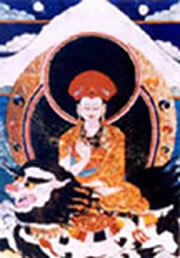 Drikung
Kagyu is a school of Tibetan Buddhism. Its founder was
Kyabpa Jigten Sumgon (1143-1217), who is believed to
be an embodiment of the Buddha of the Three Times and a reincarnation
of Arya Nagarjuna. Early in his life, he met with great masters,
received all aspects of the teachings and eventually encountered
Lord Phagmodrupa, from whom he received the complete lineage teachings.
To fully absorb these in his mind he practiced day and night until,
at the age of thirty-five, he attained Buddhahood in the Echung
Cave .
Drikung
Kagyu is a school of Tibetan Buddhism. Its founder was
Kyabpa Jigten Sumgon (1143-1217), who is believed to
be an embodiment of the Buddha of the Three Times and a reincarnation
of Arya Nagarjuna. Early in his life, he met with great masters,
received all aspects of the teachings and eventually encountered
Lord Phagmodrupa, from whom he received the complete lineage teachings.
To fully absorb these in his mind he practiced day and night until,
at the age of thirty-five, he attained Buddhahood in the Echung
Cave .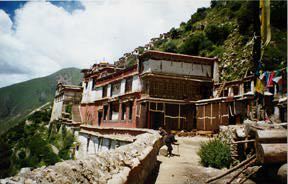 At
the request of his followers, he established a monastery at Drikung
Thil (1179), some 150 miles east of Lhasa, the capital of Tibet.
There he passed on his teachings revealing the universal law of
causes and conditions, gearing them to the cultural differences
and dogma of his hearers. Though he had thousands of disciples,
he never excluded any from his heart, wishing only to dispel their
suffering and set them free from samsara. The embodiment of wisdom
and compassion, he cut their links with their negative inclinations.
Lord Jigten Sumgon wrote many commentaries and explanations, especially
the twelve volumes known as Inner Profound Teachings and Collection
Teachings. One of his foremost works, The Gong Chik (The One Thought),
contains all the essential aspects of the Vinaya discipline, Bodhicitta
and Tantra. This text has many commentaries, both detailed and
in summary including Sherab Jungne (who was Lord Jigten Sumgon's
own disciple), the Eighth Karmapa, the Fourth Shamarpa and Drikung
Dharmakirti.
At
the request of his followers, he established a monastery at Drikung
Thil (1179), some 150 miles east of Lhasa, the capital of Tibet.
There he passed on his teachings revealing the universal law of
causes and conditions, gearing them to the cultural differences
and dogma of his hearers. Though he had thousands of disciples,
he never excluded any from his heart, wishing only to dispel their
suffering and set them free from samsara. The embodiment of wisdom
and compassion, he cut their links with their negative inclinations.
Lord Jigten Sumgon wrote many commentaries and explanations, especially
the twelve volumes known as Inner Profound Teachings and Collection
Teachings. One of his foremost works, The Gong Chik (The One Thought),
contains all the essential aspects of the Vinaya discipline, Bodhicitta
and Tantra. This text has many commentaries, both detailed and
in summary including Sherab Jungne (who was Lord Jigten Sumgon's
own disciple), the Eighth Karmapa, the Fourth Shamarpa and Drikung
Dharmakirti. 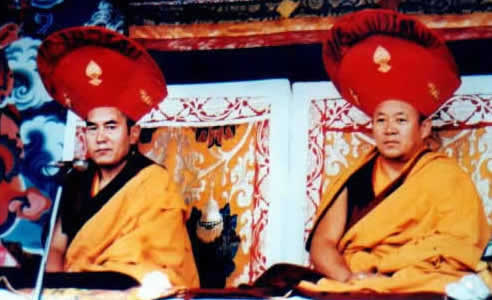
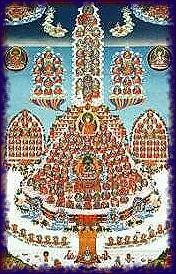 "Ka"
means the original and "Gyu" means lineage. The noble
lineage of Kagyu descended from the Indian master Tilopa
(988-1069) who, because of his extraordinarily high realization,
transmitted the sacred teachings of Vajradhara
(Dorjee Chang) directly . Tilopa received teachings from many
different masters, such as Nagarjuna, and extracted
their essence, particularly the Buddha's Vajrayana with its emphasis
on commitment until the end of samsara to the welfare of others.
"Ka"
means the original and "Gyu" means lineage. The noble
lineage of Kagyu descended from the Indian master Tilopa
(988-1069) who, because of his extraordinarily high realization,
transmitted the sacred teachings of Vajradhara
(Dorjee Chang) directly . Tilopa received teachings from many
different masters, such as Nagarjuna, and extracted
their essence, particularly the Buddha's Vajrayana with its emphasis
on commitment until the end of samsara to the welfare of others.
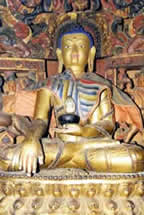 In
Bodhgaya, India, after three uncountable eons of enthusiastic
cultivation of loving compassion, merit, wisdom and the purification
all obscurities, the historical Buddha Shakyamuni
attained the highest state of enlightenment. Thereafter, for forty
years, Buddha taught the path of enlightenment in order to free
all beings. His teachings were first compiled in Pali and Sanskrit.
From then, Buddhism traveled around the universe like the rays
of the sun, arriving in Tibet in the seventh century when the
Tibetan king, Tsongtsen Gyampo (629-649 A.D), and the inventor
of the Tibetan written script, Thume Sambhota, introduced Buddhism
to Tibet.
In
Bodhgaya, India, after three uncountable eons of enthusiastic
cultivation of loving compassion, merit, wisdom and the purification
all obscurities, the historical Buddha Shakyamuni
attained the highest state of enlightenment. Thereafter, for forty
years, Buddha taught the path of enlightenment in order to free
all beings. His teachings were first compiled in Pali and Sanskrit.
From then, Buddhism traveled around the universe like the rays
of the sun, arriving in Tibet in the seventh century when the
Tibetan king, Tsongtsen Gyampo (629-649 A.D), and the inventor
of the Tibetan written script, Thume Sambhota, introduced Buddhism
to Tibet.